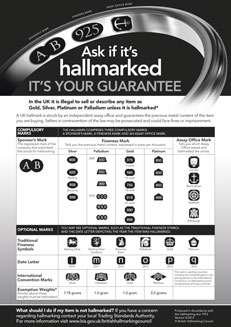
Hallmarking was originally introduced in 1300 by a Statute of Edward I and is one of the earliest forms of consumer protection.
Hallmarking is necessary because when jewellery and silverware are manufactured, precious metals are not used in their pure form, as they are too soft. Gold, Silver, and Platinum are always alloyed with copper or other metals to create an alloy that is more suitable to the requirements of the jeweller. Such an alloy needs to be strong, workable, yet still attractive.
Owing to the high value of gold, platinum and silver, there are significant profits to be gained by reducing the precious metal content of an alloy at the manufacturing stage. Base metal articles plated with a thin coat of gold or silver look the same as articles made wholly of precious metal, at least until the plating wears, and even an expert cannot determine the quality or standard of precious metal items by eye or touch alone.
With volume manufacturing, enormous profits can be made from even a small reduction in the amount of precious metal used. Without compulsory independent testing there is huge potential for deception and fraud.
The UK Hallmarking system has offered valuable protection for over 700 years. Compulsory Hallmarking protects all parties; the public who receive a guarantee of quality, the manufacturer who is given quality control and protection from dishonest competitors at a very low cost, and the retailer who avoids the near impossible task of checking standards on all his goods.
One of the requirements of the Hallmarking Act 1973 is that all dealers supplying precious metal jewellery shall display a notice explaining the approved hallmarks. This must be the notice produced by the British Hallmarking Council, as shown below. - See more at :http://www.theassayoffice.co.uk/dealers_notices.html#sthash.N5JL8sTJ.dpuf
A complete hallmark consists of three compulsory punch marks:
The Goldsmiths' Company Assay Office also applies two optional marks, at no extra cost:
Hallmarks can be applied by traditional punch or laser.
Why Hallmark?
Precious metals are rarely used in their purest form but are usually alloyed with other metals. It isn't possible to detect an article's precious metal content by sight or touch. Therefore, it is a legal requirement to hallmark articles containing precious metals if they are described as such.
The UK Hallmarking Act (1973) states that it is an offence for any person, in the course of trade or business, to describe an un-hallmarked article as being wholly or partly made of precious metal(s) or to supply un-hallmarked articles to which such a description is applied.
Dealers are required to display on their premises the statutory notice which describes the approved hallmarks. It is an offence for any dealer to fail to exhibit or keep exhibited the notice. 'Dealer' means a person engaged in the business of making, supplying, selling (including selling by auction) or exchanging articles of precious metal or in other dealings in such articles.
E.H. Warford Jewellers 73 Devonshire Road Bexhill on Sea East Sussex TN40 1BD
©2014 E.H. Warford - All rights reserved